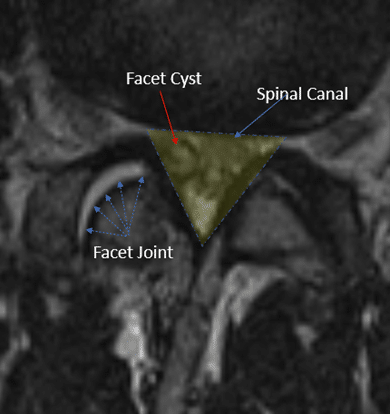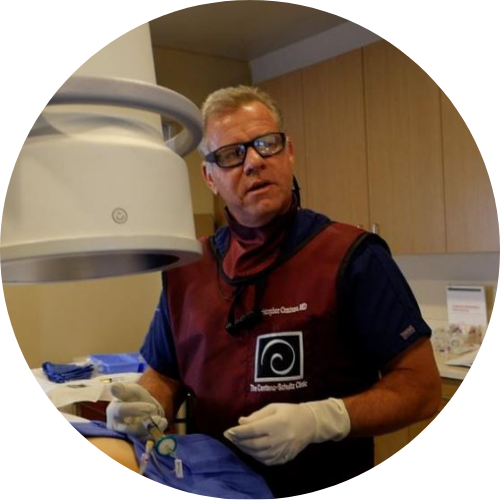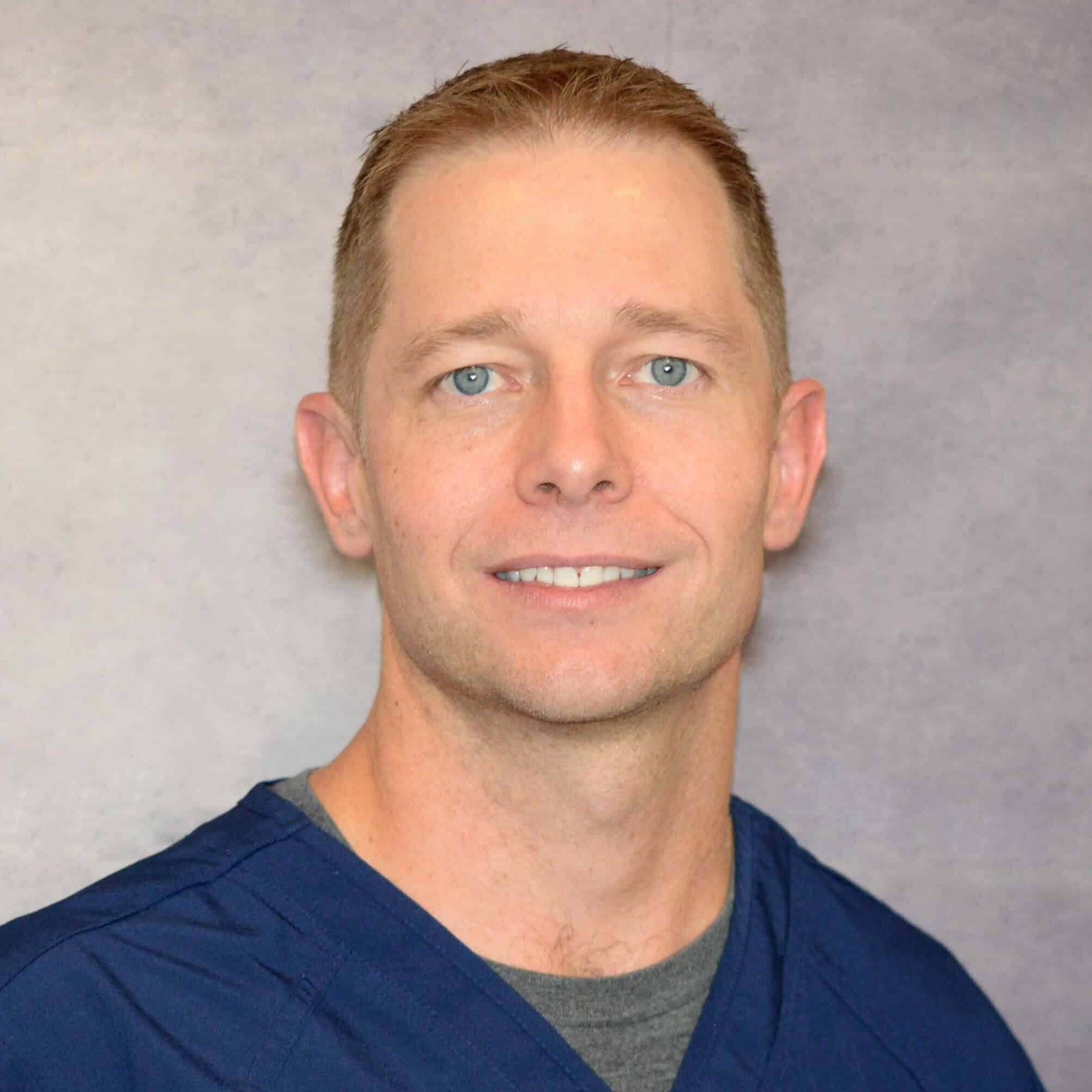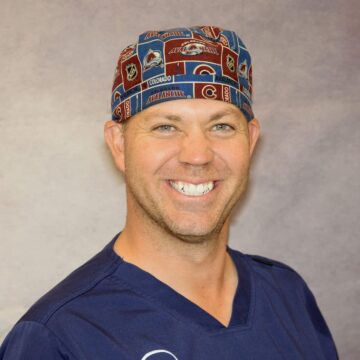Facet Synovial Cyst
Facet joint cysts are most commonly found in the lower lumbar spine, particularly at the L4-L5 level. They are more common in older individuals and may be associated with degenerative changes in the spine. Other risk factors for facet cysts include a history of trauma, spinal stenosis, and spondylolisthesis.
It is important to note that while facet cysts may be seen on imaging studies, they may not always be the cause of a patient’s symptoms. Many people with facet cysts do not experience any symptoms at all.
Clinical evaluation by a healthcare provider is necessary to determine the significance of a facet cyst in a patient’s particular case. So let’s dive into what a facet synovial cyst is and what can be done about it.
What Is Synovial Facet Cyst?
A facet cyst, also known as a synovial cyst, is a fluid-filled sac that forms in the facet joint of the spine. The facet joints are small joints located between the vertebrae of the spine that provide stability and enable movement. Facet cysts typically develop due to degeneration and wear and tear of the facet joint, which can cause the joint capsule to stretch and weaken.
This weakened capsule can then allow synovial fluid, which normally lubricates and nourishes the joint, to leak out and form a cyst. Facet cysts can cause various symptoms such as back pain, leg pain, numbness, or weakness, depending on their location and size.
The treatment options for facet cysts depend on the severity of symptoms and underlying conditions. Observation may be an option for asymptomatic cysts. Injection therapy, aspiration and injection, radiofrequency ablation, and cyst removal may be options for symptomatic cysts.
For patients with underlying facet joint degeneration, facet joint fusion may be a consideration to address the underlying pathology. It is important to note that the treatment approach should be tailored to each individual patient’s needs and preferences, and that the risks and benefits of each option should be discussed with a healthcare provider.
What Are The Symptoms Of Synovial Facet Cyst?
The symptoms of lumbar facet cysts can vary depending on the location and size of the cyst. Some individuals with lumbar facet cysts may not experience any symptoms, while others may experience one or more of the following:
- Low back pain: Pain in the lower back is a common symptom of lumbar facet cysts. The pain may be localized or may radiate to the hips, buttocks, or legs.
- Leg pain: Some individuals may experience pain that radiates down the leg, similar to sciatica. This pain may be caused by compression of the nerve roots in the area of the cyst.
- Numbness or tingling: Some individuals may experience numbness or tingling in the lower back, hips, buttocks, or legs.
- Weakness: Compression of the nerve roots may also cause weakness in the lower back, hips, or legs.
- Difficulty standing or walking: In some cases, the pain and other symptoms may make it difficult for individuals to stand or walk for extended periods.
- Bowel or bladder dysfunction: In rare cases, lumbar facet cysts can cause dysfunction of the bowel or bladder, which requires immediate medical attention.
It is important to note that these symptoms can also be caused by other conditions, and a healthcare provider should perform a thorough evaluation to determine the underlying cause of the symptoms.
Mechanical Back Pain
The symptoms listed above are exacerbated / aggravated with movements such as extension (bending backwards) or flexion (bending forwards).
Arm Throbbing
In many patients, irritated neck nerves don’t present as a symptom in the neck. In fact, sometimes the only symptoms of irritated nerves in the neck occur in the arm muscles, as either tightness, throbbing, or both. While the arm throbbing might be frustrating as it’s happening, you might not think a whole lot about it, especially if it only happens on occasion. However, ignoring it is not a good idea since it is often a warning signal of a bigger problem in the neck. These body connections occur all the way back to when we were a fetus, like the neck, shoulder, and arm.
Read More About Arm ThrobbingBig Toe Numbness
Believe it or not, one of those significant issues that can present as numbness stems from the low back. In the lumbar spine, the nerve that exits the spine at the L5 level branches down through the hip, thigh, knee, lower leg, and, yes, all the way into the foot and toes. So a pinched or irritated nerve at that L5 level in the back can create problems, such as pain, numbness, tingling, and so on, anywhere along the nerve branch. So what can irritate the L5 spinal nerve? The list is long, but it includes disc issues, such as herniated…
Read More About Big Toe NumbnessGastrointestinal (GI) Problems
Gastrointestinal (GI) problems can be debilitating comprising one’s wellbeing and ability to confidently engage in life. Symptoms vary and can include nausea, bloating, constipation, diarrhea, delayed motility, abdominal pain, irritable bowel-like symptoms, heartburn, and reflux. GI problems can be due to structural and functional problems within the gut itself. Examples include hiatal hernia and bacterial overgrowth. Less appreciated is the fact that many patients with Craniocervical instability (CCI) can also have significant GI problems. Regrettably, many of these patients undergo extensive, costly GI evaluations only are told that their examinations and studies are normal. This can be extremely frustrating. For these patients…
Read More About Gastrointestinal (GI) ProblemsLeft Arm Numbness
Treatment depends upon the underlying cause of the arm numbness. Left-arm numbness is a warning sign that requires attention. As noted above unexplained numbness requires immediate attention. At the Centeno-Schultz Clinic, we are experts in the treatment of left-arm numbness due to cervical nerve irritation, cervical stenosis, thoracic outlet syndrome, and peripheral nerve injuries. When appropriate first-line treatment should involve conservative care including physical therapy and stretching. Steroid injections should be avoided as they are toxic to orthopedic tissue and can accelerate damage. Surgery for Cervical Stenosis and Thoracic…
Read More About Left Arm NumbnessLeg Gives Out
Have you ever been walking and your leg gives out? It can be both surprising and alarming What would cause your leg to give out? Can sciatica cause your leg to give out? How do you treat weak legs? Let’s dig in.Weakness in the leg can arise from three principal sources: nerve problems, muscle weakness, and SI joint dysfunction. Weakness in the legs may indicate a significant nerve problem. In many cases, it may be the first indication of a nerve problem. There are three common causes of nerve injury: low back disorders, nerve compression as it descends down into the hip, thigh, and shin and medical conditions such as diabetes…
Read More About Leg Gives OutLower Back Pain When Sitting
After a long day on your feet sitting down is supposed to be way to relaxing. Unfortunately for some sitting for any length of time can be painful. Most people experience low back pain at some point in their life. The lifetime prevalence of low back pain is 85% (1). Let’s take a deeper look at the different types of pain and causes of low back pain when sitting. Pain can present in many different ways. It can be intermitent or constant. The quality of the low back pain can also vary depending upon the actual source of injury. Common examples include: Sharp and Stabbing, Dull and Aching, Throbbing/ Pulsating, Pins and Needles, Burning, Electrical
Read More About Lower Back Pain When SittingLower Back Pain When Standing
When you’re seated, the facet joints in your lower back are in an open and slightly flexed position. When you stand up, these joints compress. If they are painful or have arthritis, you’ll have pain as you stand up because this puts pressure on the painful joints. In addition, if there is any type of movement of one vertebra forward on another (called spondylolisthesis), then this shift will have occurred as you sit. This is called degenerative spondylolisthesis. When you get back up, the vertebrae will come back into position after a few seconds, leading to that awkward “walk it out period” that starts out painful and ends up more normal.
Read More About Lower Back Pain When StandingCommon Causes Synovial Facet Cyst
Facet cysts, also known as synovial cysts, typically develop as a result of degeneration and wear and tear of the facet joint in the spine. The following are some of the most common causes of facet cysts:
- Age-related degeneration: As people age, the facet joints in the spine may degenerate and become weaker, which can lead to the development of cysts.
- Arthritis: Osteoarthritis and other types of arthritis can cause inflammation and damage to the facet joints, which can increase the risk of cyst formation.
- Trauma: Injuries to the spine, such as fractures or sprains, can damage the facet joint and increase the risk of cyst formation.
- Genetics: Certain genetic factors may increase the risk of developing facet cysts.
- Repetitive motion: Repetitive motions, such as bending or twisting, can place stress on the facet joints and increase the risk of degeneration and cyst formation.
It is important to note that facet cysts can also be present without any known cause or risk factors, and the underlying cause of a cyst may not always be identifiable.
Common Treatment Options For A Synovial Facet Cyst
BMAC Injections For Cervical Anterior Longitudinal Ligament Injuries
Have a whiplash injury that is not getting better? Have you been told you have an anterior longitudinal ligament (ALL) injury? Want to know how you can treat the actual problem? Learn how the novel Percutaneous treatment of the Anterior Longitudinal Ligament (PALL) with Bone Marrow Aspirate Concentrate (BMAC) can help.
Read More About BMAC Injections For Cervical Anterior Longitudinal Ligament InjuriesCervical Epidural Steroid Injection
The neck pain started out as a dull ache but steadily progressed. It becomes constant and oftentimes keeps you up at night. Turning your head can send an electrical current down your arm. Rest, medications and physical therapy failed to provide much relief. Your doctor referred you to a pain clinic for a Cervical Epidural steroid injection. The injection was performed at an ambulatory surgical center. Unfortunately, the pain is now worse. What is a Cervical Epidural injection? Are there different types of Cervical Epidural injections? What are…
Read More About Cervical Epidural Steroid InjectionFacet Cyst Treatment
When a cyst develops on a facet joint in the spinal column, it can be painful and even debilitating for many patients. However, some patients may not even know they have a facet cyst as they may be asymptomatic. If you’re in the former category, and your cyst has been wreaking havoc in your back, your doctor may throw out the S word—”surgery.” Facet cyst surgery is certainly the most invasive option, but is it the only option? Let’s learn more about the facet joint and facet cysts.
Read More About Facet Cyst TreatmentFacet Joint Injections
A facet joint injection is a common medical procedure utilized in the diagnosis and treatment of facet joint injuries. It can be performed in the cervical, thoracic, and lumbar spine and may involve one or more facet joints. A facet injection involves the placement of a needle under an x-ray or ultrasound directly into the targeted facet joint and the administration of medication. The injected medicine goes directly into the joint and for this reason, some may refer to a facet injection as an intra-articular facet injection. Intra-articular refers to within the joint. The procedure can be diagnostic or therapeutic.
Read More About Facet Joint InjectionsNSAIDs
The other day I was evaluating a patient and reviewing the treatment options for their spine condition. After discussing prior treatments, we got to the topic of medications taken for pain relief. She explained that she mainly utilized anti-inflammatory (NSAID) medications and then she told me to hold much she takes and has been for many years…..she takes close to 2 grams (2000 milligrams) on a daily basis which equated to about 9-10 capsules of medication per day. I was shocked, considering she was pre-diabetic and with high blood pressure plus the kicker of it is that her PCP (primary care physician) is ok with this…
Read More About NSAIDsPerc-FSU – Trusted Alternative to Spinal Fusion
The Perc-FSU Procedure is an injection-based treatment that utilizes the patients’ own blood platelets to bring stability to the spine without the need for the rods, nuts, bolts, and hardware of fusion surgery. “Perc” stands for percutaneous, and “FSU” stands for “Functional Spinal Unit,” which means that the spine is treated as one functioning unit. Up and down the spine, the discs, facet joints, ligaments, and muscles that assist in stabilizing the spine are treated with image-guided injections of PRP and Platelet Lysate to help bring stability to the spine as a whole. It is the trusted alternative to spinal fusion.
Read More About Perc-FSU – Trusted Alternative to Spinal FusionProlotherapy For Thoracic Pain
Prolotherapy is an injection based regenerative therapy used in the treatment of ligament, tendon, muscle and spine injuries. It is minimally invasive and involves the injection of an irritant such as dextrose into the damaged or painful area. The injected irritant stimulates a delayed or frozen healing cycle thereby increasing blood flow and tissue healing. The thoracic spine is that section of the spine that is below the neck and above the low back. It is also referred to as the mid back. It has multiple components that include: Vertebral Bodies: Boney building blocks that stack one upon another…
Read More About Prolotherapy For Thoracic PainProlotherapy Injections
It has been successful in the treatment of many disorders including neck, shoulder, knee, and ankle pain. Dr. Centeno recently published an article in The Journal of Prolotherapy in which he discusses the use of x-ray guidance with prolotherapy. This ensures that the injection is in the correct place to maximize clinical results. Dr. Centeno discusses the use of prolotherapy for the treatment of neck, knee, sacroiliac joint, ankle, ischial tuberosity, and shoulder pain. At the Centeno-Schultz Clinic x-ray guided prolotherapy is just one of the therapies utilized in the successful treatment of pain. Regenerative injection therapy (RIT) or prolotherapy…
Read More About Prolotherapy InjectionsPRP Injections
PRP is short for platelet-rich plasma, and it is autologous blood with concentrations of platelets above baseline values. The potential benefit of platelet-rich plasma has received considerable interest due to the appeal of a simple, safe, and minimally invasive method of applying growth factors. PRP treatments are a form of regenerative medicine that utilizes the blood healing factors to help the body repair itself by means of injecting PRP into the damaged tissue. In regenerative orthopedics, it is typically used for the treatment of muscle strains, tears, ligament and tendon tears, minor arthritis, and joint instability. There have been more than 30 randomized controlled trials of PRP…
Read More About PRP InjectionsCan Synovial Facet Cyst Heal On Its Own?
No, typically they do not resolve on their own because the underlying issue that created the cysts is a combination of instability (ligament laxity) that furthers the degeneration and continues additional stress on the joint. If you are not addressing the underlying issue, then there is no.
How Serious Is A Synovial Facet Cyst?
Facet cysts can be very serious. If not dealt with in a timely manner, they can run the risk of needing invasive surgeries such as fusions, laminectomy, facetectomies, and more.
How Is A Synovial Facet Cyst Diagnosed?

MRI is the best tool to identify the presence of facet cysts.
X-rays, more specifically motion x-rays, are excellent at identifying the underlying issue that is causing the facet cyst,such as instability via spondylolisthesis.
Get The Right Treatment For Your Synovial Facet Cyst Condition
Facet cysts can be quite debilitating. If you have been dealing with one and failing to find results with more traditional approaches–before you have surgery that can leave your spine fused– call us for an evaluation! Our experts will evaluate you and determine if you are a candidate to help resolve the cyst and eliminate your current symptoms!

Christopher J. Centeno, MD
Christopher J. Centeno, M.D. is an international expert and specialist in Interventional Orthopedics and the clinical use of bone marrow concentrate in orthopedics.
Dr. Centeno is one of the few physicians in the world with extensive experience in the culture expansion of and clinical use of adult bone marrow concentrate to treat orthopedic injuries. His clinic incorporates a variety of revolutionary pain management techniques to bring its broad patient base relief and results. Dr. Centeno treats patients from all over the US who travel to Colorado to undergo innovative, non-surgical treatments. Dr. Centeno has chaired multiple international research-based conferences. He also maintains an active research-based practice, with multiple publications listed in the US National Library of Medicine. Dr. Centeno has also served as editor-in-chief of a medical research journal dedicated to traumatic injury.
Dr. Centeno trained at the Baylor College of Medicine, Texas Medical Center, and the Institute for Rehabilitation Research. He hails from both Florida and New York and currently resides in Boulder, Colorado with his wife and three children.

John Schultz, MD
John R. Schultz M.D. is a national expert and specialist in Interventional Orthopedics and the clinical use of bone marrow concentrate for orthopedic injuries. He is board certified in Anesthesiology and Pain Medicine and underwent fellowship training in both. Dr. Schultz has extensive experience with same day as well as culture expanded bone marrow concentrate and sees patients at the CSC Broomfield, Colorado Clinic, as well the Regenexx Clinic in Grand Cayman. Dr. Schultz emphasis is on the evaluation and treatment of thoracic and cervical disc, facet, nerve, and ligament injuries including the non-surgical treatment of Craniocervical instability (CCI). Dr. Schultz trained at George Washington School of…
Read more
John Pitts, M.D.
Dr. Pitts is originally from Chicago, IL but is a medical graduate of Vanderbilt School of Medicine in Nashville, TN. After Vanderbilt, he completed a residency in Physical Medicine and Rehabilitation (PM&R) at Emory University in Atlanta, GA. The focus of PM&R is the restoration of function and quality of life. In residency, he gained much experience in musculoskeletal medicine, rehabilitation, spine, and sports medicine along with some regenerative medicine. He also gained significant experience in fluoroscopically guided spinal procedures and peripheral injections. However, Dr. Pitts wanted to broaden his skills and treatment options beyond the current typical standards of care.
Read more
Jason Markle, D.O.
Post-residency, Dr. Markle was selected to the Interventional Orthopedic Fellowship program at the Centeno-Schultz Clinic. During his fellowship, he gained significant experience in the new field of Interventional Orthopedics and regenerative medicine, honing his skills in advanced injection techniques into the spine and joints treating patients with autologous, bone marrow concentrate and platelet solutions. Dr. Markle then accepted a full-time attending physician position at the Centeno-Schultz Clinic, where he both treats patients and trains Interventional Orthopedics fellows. Dr. Markle is an active member of the Interventional Orthopedic Foundation and serves as a course instructor, where he trains physicians from around the world.
Read more
Brandon T. Money, D.O., M.S.
Dr. Money is an Indiana native who now proudly calls Colorado home. He attended medical school at Kansas City University and then returned to Indiana to complete a Physical Medicine and Rehabilitation residency program at Indiana University, where he was trained on non-surgical methods to improve health and function as well as rehabilitative care following trauma, stroke, spinal cord injury, brain injury, etc. Dr. Money has been following the ideology behind Centeno-Schultz Clinic and Regenexx since he was in medical school, as he believed there had to be a better way to care for patients than the status quo. The human body has incredible healing capabilities…
Read moreMore Resources for Facet Synovial Cyst

The Spine Owner’s Manual: How to Avoid Back Pain & Life-Altering Surgery
This e-book from Dr. Chris Centeno focuses on the spine and how it functions within the human musculoskeletal system and the body as a whole. Everything in our bodies works together like a well-tuned symphony to support our well-being, and a strong spine (including all of its component parts, such as spinal nerves, ligaments, muscles, etc.) is critical to complete health.
Using the Regenexx SANS approach, The Spine Owner’s Manual provides a series of tests and clearly defined exercises that you can do on your own to measure and monitor your own spinal health. These musculoskeletal tests will allow you to monitor where your own body might be struggling to maintain proper stability, articulation, symmetry, and neuromuscular function.
Relevant Articles
-
8 Golf Stretches For Your Back to Avoid Pain
Golf may look like a low-impact sport to the untrained eye, but seasoned players know that it can take a serious toll on your body—especially your back. Between repetitive swinging, bending, twisting, and walking the course, it’s no surprise that back pain is among the most common complaints among golfers. If not addressed, these issues…
-
Exploring the Long-Term Effects of Post-Concussion Syndrome
Post-concussion syndrome (PCS) (aka persistent post-concussion symptoms) is a condition that often arises after a concussion, which is one type of traumatic brain injury (TBI). It is characterized by symptoms that persist long after the initial injury, leading to significant long-term effects that can impact both physical and mental health. While most people recover from…
-
Concussion Headaches And Why the Right Diagnosis Is Critical
Concussion headaches often occur after traumatic brain injuries. They can result from mechanical impacts and chemical changes in the brain. These headaches can cause persistent pain, sensitivity to light, and cognitive issues. It is important to accurately diagnose them to distinguish them from other types, like migraines or tension-type headaches. If untreated, they may lead…
-
Learn Why Your Neck Hurts
Globally, neck pain is estimated to affect 203 million people, making it one of the most common musculoskeletal pains worldwide. It often stems from a combination of factors, such as muscle strain, poor posture, and degenerative disc conditions. This pain can limit movement, disrupt daily life, and, in severe cases, impact overall health. While some…
-
What Happens If You Have Back Pain From Golf?
Back pain is a common complaint among golfers, impacting both amateur enthusiasts and professional athletes. Golf, while seemingly low-impact, involves repetitive, high-intensity movements that can stress the spine and surrounding structures. Understanding the causes, symptoms, and preventative measures for golf-related back pain can help maintain performance and long-term health. Golf And Back Pain The golf…
-
The C1 And C2 Vertebrae – What To Know
The C1 and C2 vertebrae, also known as the atlas and axis, are the uppermost bones in the spinal column. They play a crucial role in supporting the skull and enabling head movements. Damage or injury to these vertebrae often leads to pain, limitations to daily activities, and reduced quality of life. Many patients, without…
Are you a Candidate?